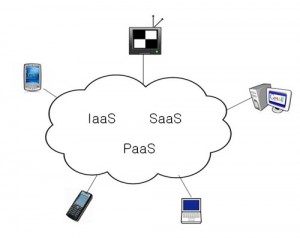 Cloud computing and virtualization have generated huge interest from all size enterprises. Startups, small and medium size enterprises (SMEs) have started adopting the cloud computing concept faster than larger enterprises with more mature IT departments, mainly because of data security concerns and harder implementation procedures.
Cloud computing and virtualization have generated huge interest from all size enterprises. Startups, small and medium size enterprises (SMEs) have started adopting the cloud computing concept faster than larger enterprises with more mature IT departments, mainly because of data security concerns and harder implementation procedures.
Although spending in cloud computing is still at a fraction of the IT market spend, it is predicted that revenues from cloud services will increase at a pace of 19% in 2011 compared to 2010 and will double by 2014.
The adoption of cloud computing is fueled by its cost advantage; enterprises have now the ability to reduce the need for networks, servers, software, storage, human capital, and space. Cloud computing players offer pay-as-you-use style or on a subscription basis, with little or no upfront cost.
Cloud computing encompasses a number of variations, Software as a Service (SaaS), Infrastructure as a Service (IaaS), Platform as a Service (PaaS).
SaaS – Software as a Service
The software is developed/hosted by vendors, and delivered to customers as a service over the internet. What distinguishes SaaS from the ASP model is that SaaS applications provide better economies of scale, particularly when it comes to the support and the deployment of the software life cycle. SaaS will continue to dominate spending in the cloud space through 2014, including social networking and mobility solutions.
Main features of SaaS:
- Commercially available network access and control over software. Centrally located functions so customers will have access to remote applications via the Internet.
- Pay as you go, on a subscription basis and bandwidth usage
- Features can be centrally updated, which eliminates the need for patches and upgrades.
SaaS has 4 maturity levels which involve scalability, efficiency of the multi-talent and configurability. The first level requires low level of development and cost, and the software may be customized, this means that each user has a customized version of the software, and can run a request via the vendor’s host. Level II involves configuration of the software for greater flexibility. Level III involves configurability and multi-tenant efficiency. Level VI involves scalability, configurability and multi-tenant efficiency.
IaaS – Infrastructure as a Service
IaaS can be described as a virtual server. Enterprises can forgo buying servers, networks, and data-centers storage and instead buy those services as a fully outsourced service from a cloud infrastructure provider. IaaS vendors typically charge for these services on a subscription basis and bandwidth usage. It is believed that by 2012 IaaS providers would have resolved the issues currently inherent with the service and that involve lack of standards, and transaction and data security. IaaS will be more recognized, less for its cost saving value, but more for its flexibility for large enterprise and service levels and compliance for SMBs.
PaaS – Platform as a Service
PaaS or platform as a service is a computing platform that provides companies the ability to host and deliver web applications and services via a web browser without the costs associated with buying and maintaining hardware and software. Unlike IaaS, PaaS has an integrated software layer which permits the development of applications using Java, PHP, XML and others. PaaS, will be somewhat slow to emerge in the next couple of years, as enterprises of all shapes and sizes transition to a new way of managing their application portfolios.
As enterprises look down the road, they will move from just Software as a Service into a hybrid model, where they’re going to embrace Infrastructure and Platform as a Service. This move really forms the foundation of what the cloud is and what we can see of it today. But, it will continue to evolve, mature, and offer new things that we don’t even know about yet.